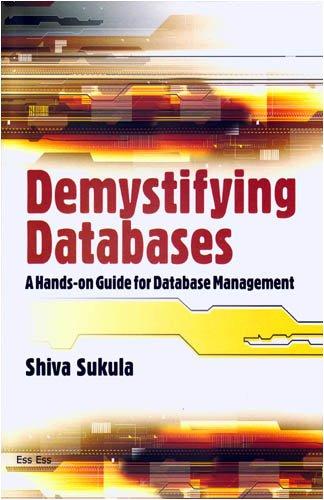Question
1 Basic graph class/methods The purpose of this lab is to get some experience with graph algorithms, representing graphs, and storing graphs. In a graph,
1 Basic graph class/methods
The purpose of this lab is to get some experience with graph algorithms, representing graphs, and storing graphs. In a graph, each vertex is represented as a class node with a name and an id number. To make things simple, we will consider representing the entire graph as an adjacency list (an adjacency matrix wouldve worked just as fine too). As an example, here is the C++ code for representing a single node, as well as methods for populating its adjacency list1. This is just given as an example of the classes/methods required, you can feel free to write similar classes and methods in any language of your choice.
class Node {
private : string m_name; // a string that labels the node int m_id; // a unique integer from 0 to n-1, where n is the total number of nodes // i.e., n =|V|
public : Node() {}; Node(const string & name, int id) {m_name = name, m_id = id;}; int id() const { return m_id;}; const string & name() const { return m_name;};
Design a graph class using adjacency list, it must contain the following members and functions:
class Graph { private : vector< Node > m_nodes; vector < list > m_adjList; public : // Construct the graph from a file of edges Graph(const string & file );
// Insert a edge (a, b) to m_adjList void addEdge(const Node & a, const Node & b);
// Insert a node a to m_nodes void addNode(const Node & a) { m_nodes[a.id()] = a;}; // Return node with id equal to i const Node & getNode(size_t i) const { return m_nodes[i]; } // Return reference of the adjacency list of node a list& getAdjNodes(const Node & a) { return m_adjList[a.id ()];}
// Return constant reference to adjacency list of node a const list& getAdjNodes(const Node & a) const { return m_adjList[a.id ()];}
// Return the total number of nodes in the graph size_t num_nodes() const { return m_nodes. size (); } // Create a graph from a tab-separated text edge list file to adjacency lists void scan(const string & file );
// Save a graph from adjacency lists to a tab- separated text edge list file void save(const string & file) const; };
Once this is done, we need a file format to store into, and read graph data from in our program. One way to do this is to store the graph as tab separated text file containing a list of edges in the graph, specified by the source and destination nodes of each edge, one on each row, e.g.,
a b
a d
b d
c b
d c
There are several visualization tools such as R and Matlab for visualizing graphs, you can use them if youd like, and are familiar with them, but are not required to do so for this lab.
2 DFS
(Textbook: https://www.chegg.com/homework-help/Algorithms-1st-edition-chapter-0-problem-1-solution-9780077388492 )
Now, implement the DFS algorithm we had talked about in class textbook algorithm 3.3, and 3.5. Use the graph text file as G. You need to make small changes or enhancements to the code above to remember the pre-visit (first time a node is visited), and post-visit (last time we depart from a node) numbers.
3 Testing the DFS algorithm
Generate five example graphs to test your code. The graphs do not have to be very large but try to represent a variety: cyclic/acyclic, directed/undirected.
Step by Step Solution
There are 3 Steps involved in it
Step: 1

Get Instant Access to Expert-Tailored Solutions
See step-by-step solutions with expert insights and AI powered tools for academic success
Step: 2

Step: 3

Ace Your Homework with AI
Get the answers you need in no time with our AI-driven, step-by-step assistance
Get Started


